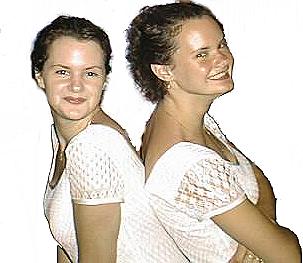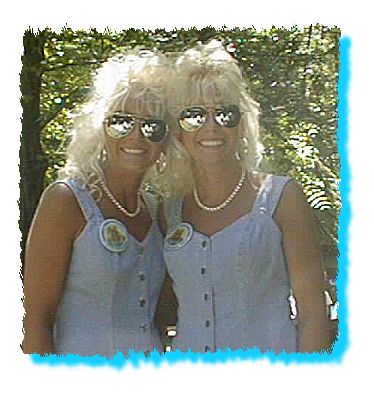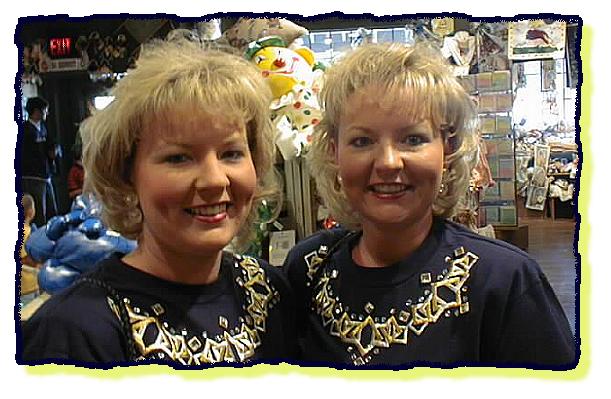
THE TWINS PAGE

THE SPECIAL BOND
Heidi and Paul Jackson�s twin girls,
Brielle and Kyrie,
were born October 17, 1995.
They were born 12 weeks ahead
of their due date.
Standard hospital practice
is to place preemie twins
in separate incubators
to reduce the risk of infection.
This was done for the Jackson twins
in the neonatal intensive care unit
at The Medical Center of
Central Massachusetts in Worcester.
Kyrie, the larger sister
at two pounds, three ounces,
quickly began gaining weight
and calmly sleeping her newborn days away.
Brielle, on the other hand,
who weighed only two pounds at birth,
could not keep up with her.
Brielle had breathing and heart-rate problems.
The oxygen level in her blood was low
and her weight gain was slow.
Suddenly, on November 12,
Brielle went into critical condition.
She began gasping for breath.
Her face and stick-thin arms
and legs turned bluish gray.
Her heart rate was way up
and she got the hiccups,
a dangerous sign
that her body was under stress.
Her parents watched,
terrified that she might die.
Nurse Gayle Kasparian,
tried everything she could think of
to stabilize Brielle.
She suctioned her breathing passages
and turned up the oxygen flow
to the incubator.
Still Brielle squirmed and fussed
as her oxygen intake plummetted
and her heart rate soared.
Then Kasparian remembered something
she had heard from a colleague.
It was a new procedure,
common in parts of Europe,
but almost unheard of in the United States
that called for double-bedding
multiple birth babies ~ especially preemies.
Kasparian�s nurse manager, Susan Fitzback,
was away at a conference,
and the arrangement was unorthodox.
Gayle Kasparian decided to take the risk.
"Let me try putting Brielle
in with her sister to see if it helps,"
she said to her parents.
"I don�t know what else to do."
The Jacksons quickly gave their consent,
and Kasparian slipped the squirming baby
into the incubator holding the sister
Brielle had not seen since birth.
Then Kasparian and the Jacksons watched.
No sooner had the door of the incubator closed
than Brielle snuggled up to Kyrie
and calmed down immediately.
Within minutes Brielle�s blood-oxygen readings
were the best they had been since she was born.
And as Brielle dozed,
Kyrie wrapped her tiny arm
around her smaller sibling.
By coincidence,
the conference Fitzback was attending
included a presentation on double-bedding
that caused Fitzback to contemplate ~
This is something I want to see happen
at the Medical Center, but it might be
hard making the change.
On her return she was doing rounds
when the nurse caring for the twins
that morning motioned to her.
"Sue, take a look in that isolette over there."
"I cannot believe this," Fitzback exclaimed.
"This is so beautiful."
"You mean we can do it?" asked the nurse.
"Of course we can," Fitzback replied.
Soon a handful of institutions
around the country were adopting double-bedding,
which seemed to reduce the number of hospital days.
The practice is growing quickly,
even though the first scientific studies on it
did not begin until the following January.
Heidi and Paul Jackson
don�t need any studies to know
that double-bedding helped Brielle.
Brielle is thriving.
In fact, now that Brielle and Kyrie are home,
they still sleep together.
And they still snuggle.
By Nancy Sheehan
Worcester Gazette 1995

LET�S CHECK OUT A FEW TWINS
AND SEE WHAT MAKES TWINS
SOMETHING REALLY SPECIAL!





AND IF YOU THINK
TWINS ARE SOMETHING ~
WHAT ABOUT TRIPLETS!

THERE WILL BE MORE TO COME
AS GOOD STUFF MATERIALIZES!


